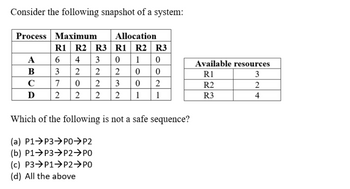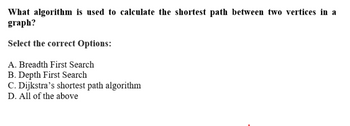Question
thumb_up100%

Transcribed Image Text:Consider the following snapshot of a system:
Process Maximum
A
B
C
D
R1 R2 R3 R1 R2
R3
6
4 3 0 1
0
3 2 2 2
0
0
7
3
0
2
2 2
2 1 1
ON
Allocation
222
Which of the following is not a safe sequence?
(a) P1 P3 PO➜P2
(b) P1 P3 P2➜PO
(c) P3 P1 P2 →PO
(d) All the above
Available resources
R1
3
R2
2
R3
4

Transcribed Image Text:What algorithm is used to calculate the shortest path between two vertices in a
graph?
Select the correct Options:
A. Breadth First Search
B. Depth First Search
C. Dijkstra's shortest path algorithm
D. All of the above
Expert Solution
This question has been solved!
Explore an expertly crafted, step-by-step solution for a thorough understanding of key concepts.
This is a popular solution
Trending nowThis is a popular solution!
Step by stepSolved in 3 steps

Knowledge Booster
Similar questions
- Process PI P2 P3 P4 P5 Buast time 2 1 8 4 5 Priority (2*xx) %5 (2xxx) 5 (2*XX) 0/0 5 (2*XX) do 5 (2*xx) do 5 ✓ 11 Value of XX is 5 All processes Arrives at time + = 0 ms. Draw the Gantt chart for priority scheduling (A larger priority number implies higher priority)arrow_forwardIn the following resource allocation graph, are the processes deadlocked? If “yes” explain why and state which processes are involved in deadlock. If “not” explain why.arrow_forwardEight batch jobs arrive almost at the same time in the following order: I₁, 2, ..., II8. The table below contains their running times and priorities: Job П1 П2 П3 П4 П П П П Running time (in min) 4 5 5 10 8 10 7 Priority 1 7 5 2 8 6 4 3 The highest priority is 1. For each of the following scheduling algorithms, determine the order of execution of processes and the mean process turnaround time: (a) priority scheduling; (b) first-come, first-served; (c) shortest job first. Scheduling is non-preemptive.arrow_forward
- Consider the following snapshot of a system: Allocation Маx Available ABCD ABCD ABCD PO 2001 4212 3321 P1 3121 5252 P2 2103 2316 P3 1312 1424 P4 1432 3665 a. Illustrate that the system is in a safe state by demonstrating an order in which the processes may complete.arrow_forwardIn the following resource allocation graph, are the processes deadlocked? If “yes” explain why and state which processes are involved in deadlock. If “not” explain why.arrow_forward
arrow_back_ios
arrow_forward_ios